Inhomogeneous Strain Behaviors of the High Strength Pipeline Girth Weld under Longitudinal Loading
Abstract
1. Introduction
2. Experimental Procedure
2.1. Materials
2.2. DIC-Assisted Cross-Weld Tensile Test
2.3. Microstructure Characterization and Hardness Mapping
3. Results and Discussion
3.1. Heterogeneous Microstructures of Base Metal, Weld Metal and HAZ
3.2. Heterogeneous Mechanical Properties of Girth Welds
3.3. Inhomogeneous Strain Behavior and Evolution of Strain Distribution during Tensile Testing
3.3.1. Effect of Reinforcement on Tensile Strain Behavior in Pipeline Girth Welds
3.3.2. Mechanism of Strain Migration of Undermatched Girth Welds
3.3.3. Effect of Welding Processes on Tensile Strain Evolution in Pipeline Girth Welds
4. Conclusions
Author Contributions
Funding
Institutional Review Board Statement
Informed Consent Statement
Data Availability Statement
Acknowledgments
Conflicts of Interest
List of Abbreviations
| AF | Acicular ferrite |
| BF | Bainitic ferrite |
| BM | Base metal |
| CGHAZ | Coarse-grain heat-affected zone |
| DIC | Digital image correlation |
| FGHAZ | Fine-grain heat-affected zone |
| GB | Granular bainite |
| GF | Grain boundary ferrite |
| GMAW | Gas metal arc welding |
| HAZ | Heat-affected zone |
| ICCGHAZ | Inter-critical reheated coarse-grain heat-affected zone |
| ICHAZ | Inter-critical heat-affected zone |
| M/A | Martensite–austenite constituent |
| P | Pearlite |
| PF | Polygonal ferrite |
| SCHAZ | Sub-critical heat-affected zone |
| SMAW | Shielded metal arc welding |
| UTS | Ultimate tensile strength |
References
- Wang, Y.; Jia, D. Managing standards with evolving industry practice-lessons learned from girth weld failures in newly constructed pipelines. In Proceedings of the Technology for Future and Ageing Pipelines, Gent, Belgium, 19–21 October 2022. [Google Scholar]
- Wang, Y.; Jia, D.; Johnson, D.; Rapp, S.; Horsley, D. Low strain capacity girth welds of newly constructed pipelines and its implications in integrity management. In Proceedings of the 22nd Joint Technical Meeting on Pipeline Research, Brisbane, Australia, 29 April–3 May 2019. [Google Scholar]
- Wang, Y.; Wang, B.; Liu, B.; Jia, D.; Steve, R.; Otto, J.H. Strain capacity of vintage girth welds and integrity management process. In Proceedings of the 22nd Joint Technical Meeting on Pipeline Research, Brisbane, Australia, 29 April–3 May 2019. [Google Scholar]
- Haider, S.F.; Quazi, M.; Bhatti, J.; Bashir, M.N.; Ali, I. Effect of Shielded Metal Arc Welding (SMAW) parameters on mechanical properties of low-carbon, mild and stainless-steel welded joints: A review. J. Adv. Technol. Eng. Res. 2019, 5, 191–198. [Google Scholar] [CrossRef]
- Ibrahim, I.A.; Mohamat, S.A.; Amir, A.; Ghalib, A. The Effect of Gas Metal Arc Welding (GMAW) processes on different welding parameters. Procedia Eng. 2012, 41, 1502–1506. [Google Scholar] [CrossRef]
- Mohandas, T.; Reddy, G.M.; Kumar, B.S. Heat-affected zone softening in high-strength low-alloy steels. J. Mater. Process. Technol. 1999, 88, 284–294. [Google Scholar] [CrossRef]
- Chen, X.; Liao, B.; Qiao, G.; Gu, Y.; Wang, X.; Xiao, F. Effect of Nb on mechanical properties of HAZ for high-Nb X80 pipeline steels. J. Iron Steel Res. Int. 2013, 20, 53–60. [Google Scholar] [CrossRef]
- Pisarski, H.G.; Tkach, Y.; Quintana, M. Evaluation of weld metal strength mismatch in X100 pipeline girth welds. In Proceedings of the International Pipeline Conference, Calgary, AB, Canada, 4–8 October 2004. [Google Scholar]
- Wang, Y.; Kotian, K.; Rapp, S. Effects of High-Low Misalignment on Girth Weld Integrity. In Proceedings of the International Pipeline Conference, Calgary, AB, Canada, 29 September–3 October 2014. [Google Scholar]
- Wang, G.; Quan, L.; Li, Y.; Wu, A.; Yan, D.; Wu, H. Effects of weld reinforcement on tensile behavior and mechanical properties of 2219-T87 aluminum alloy TIG welded joints. Trans. Nonferrous Met. Soc. China 2017, 27, 10–16. [Google Scholar] [CrossRef]
- Ma, M.; Lai, R.; Qin, J.; Wang, B.; Liu, H.; Yi, D. Effect of weld reinforcement on tensile and fatigue properties of 5083 aluminum metal inert gas (MIG) welded joint: Experiments and numerical simulations. Int. J. Fatigue 2021, 144, 106046. [Google Scholar] [CrossRef]
- AS 2885.2-2016; Australian Standard. Pipelines-Gas and Liquid Petroleum, Part 2: Welding. Australian Standard: Sydney, Australia, 2016.
- Yang, Z.; Kumar, S.; Tronskar, J.P. ECA of Pipeline with Girth Weld Strength Mis-Matching Subjected to Large Strain. In Proceedings of the ASME 2009 28th International Conference on Ocean, Offshore and Arctic Engineering, Honolulu, HI, USA, 31 May–5 June 2009; pp. 75–82. [Google Scholar]
- Igi, S.; Sakimoto, T.; Endo, S. Effect of Internal Pressure on Tensile Strain Capacity of X80 Pipeline. Procedia Eng. 2011, 10, 1451–1456. [Google Scholar] [CrossRef]
- Fonseca, E.M.; de Melo, F.; Oliveira, C. Trigonometric function used to formulate a multi-nodal finite tubular element. Mech. Res. Commun. 2007, 34, 54–62. [Google Scholar] [CrossRef]
- Sutton, M.A.; Turner, J.L.; Chao, Y.J.; Bruck, H.A.; Chae, T.L. Experimental investigations of three-dimensional effects near a crack tip using computer vision. Int. J. Fract. 1992, 53, 201–228. [Google Scholar] [CrossRef]
- Gang, H.; Sutton, M.A.; Chao, Y.J.; Lyons, J.S. A study of stable crack growth in thin SEC specimens of 304 stainless steel by computer vision. Eng. Fract. Mech. 1995, 52, 525–531. [Google Scholar]
- Gonzalez, J.; Knauss, W.G. Strain inhomogeneity and discontinuous crack growth in a particulate composite. J. Mech. Phys. Solids 1998, 46, 1981–1995. [Google Scholar] [CrossRef]
- Chevalier, L.; Calloch, S.; Hild, F.; Marco, Y. Digital image correlation used to analyze the multiaxial behavior of rubber-like materials. Eur. J. Mech.-A/Solids 2001, 20, 169–187. [Google Scholar] [CrossRef]
- Reder, C.; Loidl, D.; Puchegger, S.; Gitschthaler, D.; Peterlik, H.; Kromp, K.; Khatibi, G.; Betzwar-Kotas, A.; Zimprich, P.; Weiss, B. Non-contacting strain measurements of ceramic and carbon single fibres by using the laser-speckle method. Compos. Part A 2003, 34, 1029–1033. [Google Scholar] [CrossRef]
- Milosevic, N.; Sedmak, A.; Jovicic, R. Analysis of strain distribution in overmatching V groove weld using digital image correlation. Procedia Struct. Integr. 2018, 13, 1600–1604. [Google Scholar] [CrossRef]
- Peng, Y.; Wu, C.; Gan, J.; Dong, J. Determination of the local constitutive properties of the welded steel joints using digital image correlation method. Constr. Build. Mater. 2018, 171, 485–492. [Google Scholar] [CrossRef]
- Huda, N.; Gianetto, J.; Ding, Y.; Lazor, R.; Gerlich, A.P.; A, E. Investigation of local tensile strength and ductility properties of an X100 submerged arc seam weld. Mater. Sci. Eng. A 2019, 768, 138475. [Google Scholar] [CrossRef]
- Zhang, Y.; Shuai, J.; Ren, W.; Lv, Z. Investigation of the tensile strain response of the girth weld of high-strength steel pipeline. J. Constr. Steel Res. 2022, 188, 107047. [Google Scholar] [CrossRef]
- Barbaro, F.; Fletcher, L. Undermatching and Low Strain In-Service Failures in X70 Line Pipe: Contributions from Standards, Specifications and Coating. In Proceedings of the International Pipeline Conference, Virtual Online, 28–30 September 2020. [Google Scholar]
- AS 2205.2.1-2003; Methods for Destructive Testing of Welds in Metal Transverse Butt Tensile Test. Standards Australia: Sydney, Australia, 2003.
- Paul, S.K.; Roy, S.; Sivaprasad, S.; Bar, H.N.; Tarafder, S. Identification of Post-necking Tensile Stress–Strain Behavior of Steel Sheet: An Experimental Investigation Using Digital Image Correlation Technique. J. Mater. Eng. Perform. 2018, 27, 5736–5743. [Google Scholar] [CrossRef]
- Ren, S.C.; Morgeneyer, T.F.; Mazière, M.; Forest, S.; Rousselier, G. Effect of Lüders and Portevin–Le Chatelier localization bands on plasticity and fracture of notched steel specimens studied by DIC and FE simulations. Int. J. Plast. 2021, 136, 102880. [Google Scholar] [CrossRef]
- EN ISO 6507–1; Metallic materials—Vickers Hardness Test. Part 1: Test Method. International Organization for Standardization: Geneva, Switzerland, 2018.
- Sharma, S.K.; Maheshwari, S. Engineering. A review on welding of high strength oil and gas pipeline steels. J. Nat. Gas Sci. 2017, 38, 203–217. [Google Scholar] [CrossRef]
- Tadavi, T.; Jogi, B.; Dhende, S.; Banait, S.; Wagh, P. Microscopic analysis of heat affected zone (HAZ) of submerged arc welding (SAW) joint for 1018 mild steel sheet. In Proceedings of the International Conference on Communication and Signal Processing 2016 (ICCASP 2016), Lonere, India, 26–27 December 2016. [Google Scholar]
- Ma, Y.; Su, L.; Shen, C.; Fletcher, L.; Li, H.; Sun, L.; Zheng, L.; Zhang, C. Improving the Weld Heat-Affected-Zone (HAZ) Toughness of High-Strength Thick-Walled Line Pipes. Metals 2023, 13, 2018. [Google Scholar] [CrossRef]
- Guillala, A.; Abdelbakib, N.; Gaceba, M.; Bettayeba, M. Effects of martensite-austenite constituents on mechanical properties of heat affected zone in high strength pipeline steels-review. Chem. Eng. Trans. 2018, 70, 583–588. [Google Scholar]
- Yu, H.; Wu, K.; Dong, B.; Liu, J.; Liu, Z.; Xiao, D.; Jin, X.; Liu, H.; Tai, M. Effect of heat-input on microstructure and toughness of CGHAZ in a high-Nb-content microalloyed HSLA steel. Materials 2022, 15, 3588. [Google Scholar] [CrossRef] [PubMed]
- Zhu, Z.; Marimuthu, M.; Kuzmikova, L.; Li, H.; Barbaro, F.; Zheng, L.; Bai, M.; Jones, C. Influence of Ti/N ratio on simulated CGHAZ microstructure and toughness in X70 steels. Sci. Technol. Weld. Join. 2013, 18, 45–51. [Google Scholar] [CrossRef]
- Wang, X.; Ma, X.; Wang, Z.; Subramanian, S.; Xie, Z.; Shang, C.; Li, X. Carbon microalloying effect of base material on variant selection in coarse grained heat affected zone of X80 pipeline steel. Mater. Charact. 2019, 149, 26–33. [Google Scholar] [CrossRef]
- Liu, D.; Cheng, B.; Chen, Y. Strengthening and toughening of a heavy plate steel for shipbuilding with yield strength of approximately 690 MPa. Metall. Mater. Trans. A 2013, 44, 440–455. [Google Scholar] [CrossRef]
- Zhu, L.; Luo, J.; Wu, G.; Han, J.; Chen, Y.; Song, C. Study on strain response of X80 pipeline steel during weld dent deformation. Eng. Fail. Anal. 2021, 123, 105303. [Google Scholar] [CrossRef]
- AS 2885.1-2007; Australian Standard. Pipelines-Gas and Liquid Petroleum, Part 1: Design and Construction. Standards Australia: Sydney, Australia, 2007.
- Ohaeri, E.G.; Szpunar, J. An overview on pipeline steel development for cold climate applications. J. Pipeline Sci. Eng. 2022, 2, 1–17. [Google Scholar] [CrossRef]
- Lee, M.M.; Llewelyn-Parry, A. Strength of ring-stiffened tubular T-joints in offshore structures—: A numerical parametric study. J. Constr. Steel Res. 1999, 51, 239–264. [Google Scholar] [CrossRef]
- Zhou, P.; Wang, B.; Wang, L.; Hu, Y.; Zhou, L. Effect of welding heat input on grain boundary evolution and toughness properties in CGHAZ of X90 pipeline steel. Mater. Sci. Eng. A 2018, 722, 112–121. [Google Scholar] [CrossRef]
- Fu, C.; Li, X.; Li, H.; Han, T.; Han, B.; Wang, Y. Influence of ICCGHAZ on the low-temperature toughness in HAZ of Heavy-wall X80 pipeline steel. Metals 2022, 12, 907. [Google Scholar] [CrossRef]
- Wang, X.; Yuan, G.; Zhao, J.-h.; Wang, G. Microstructure and strengthening/toughening mechanisms of heavy gauge pipeline steel processed by ultrafast cooling. Metals 2020, 10, 1323. [Google Scholar] [CrossRef]
- Niu, T.; Kang, Y.; Gu, H.; Yin, Y.; Qiao, M. Precipitation behavior and its strengthening effect of X100 pipeline steel. J. Iron Steel Res. Int. 2010, 17, 73–78. [Google Scholar] [CrossRef]
- Zhao, H.; Wynne, B.; Palmiere, E. Effect of austenite grain size on the bainitic ferrite morphology and grain refinement of a pipeline steel after continuous cooling. Mater. Charact. 2017, 123, 128–136. [Google Scholar] [CrossRef]
- Ramirez, M.F.; Hernández, J.W.; Ladino, D.H.; Masoumi, M.; Goldenstein, H. Effects of different cooling rates on the microstructure, crystallographic features, and hydrogen induced cracking of API X80 pipeline steel. J. Mater. Res. Technol. 2021, 14, 1848–1861. [Google Scholar] [CrossRef]
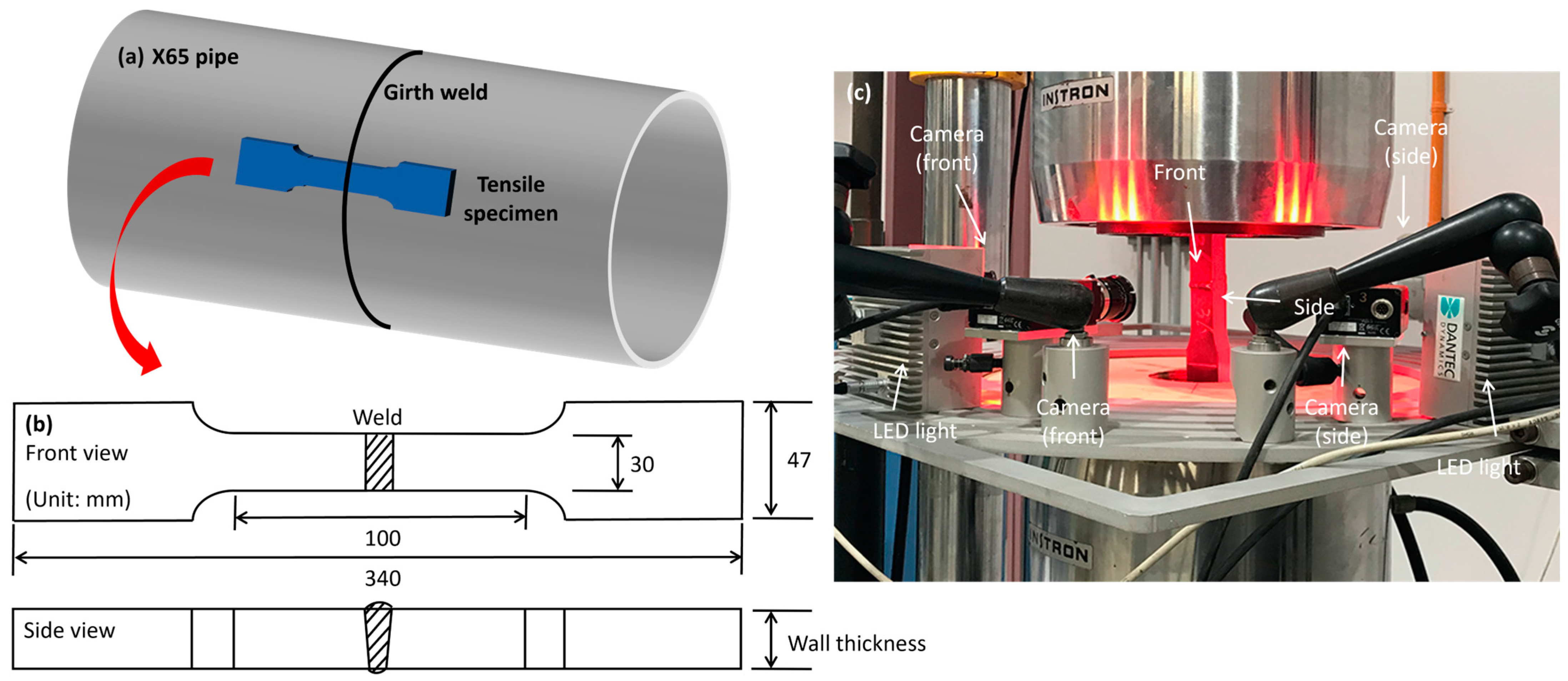
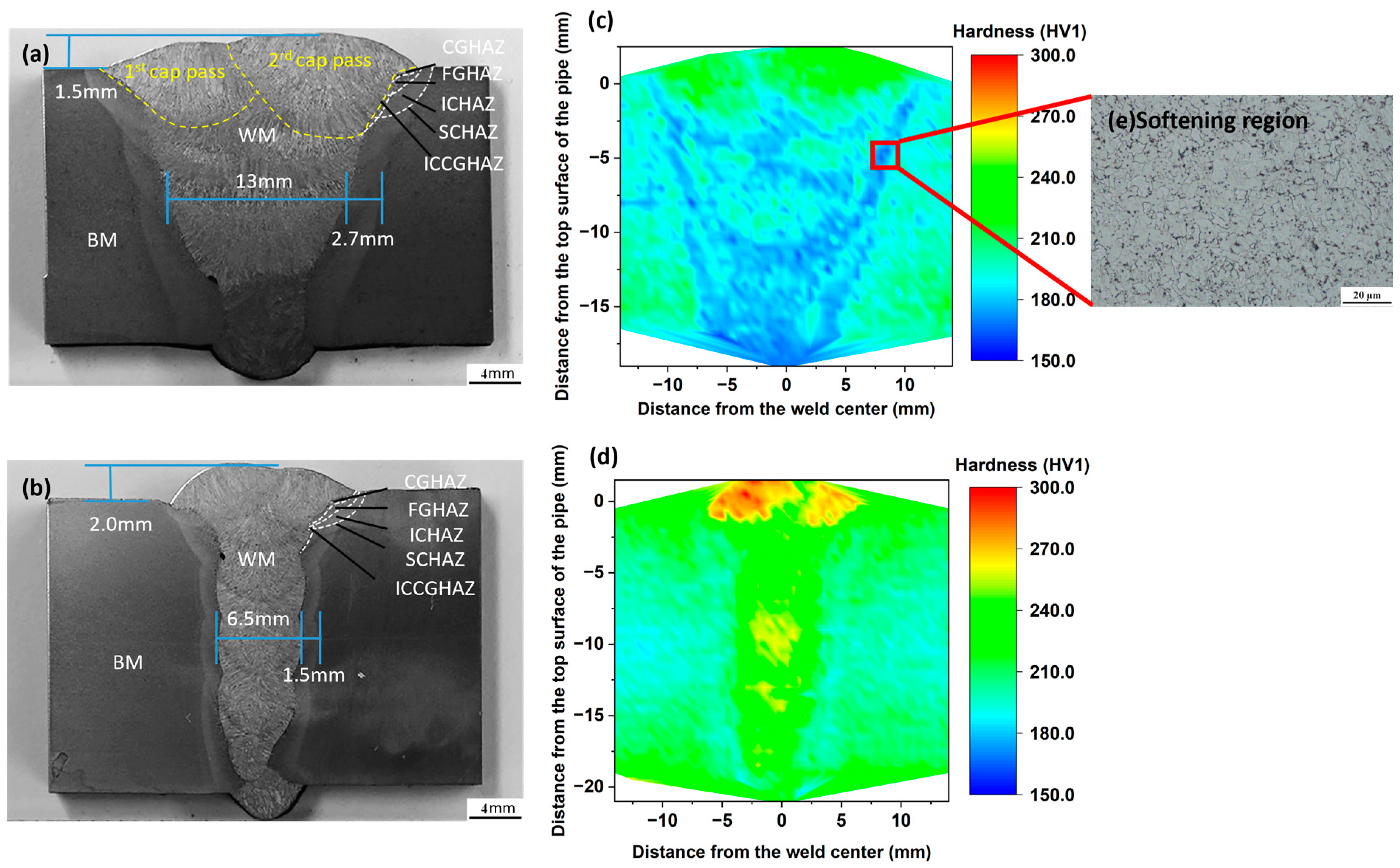
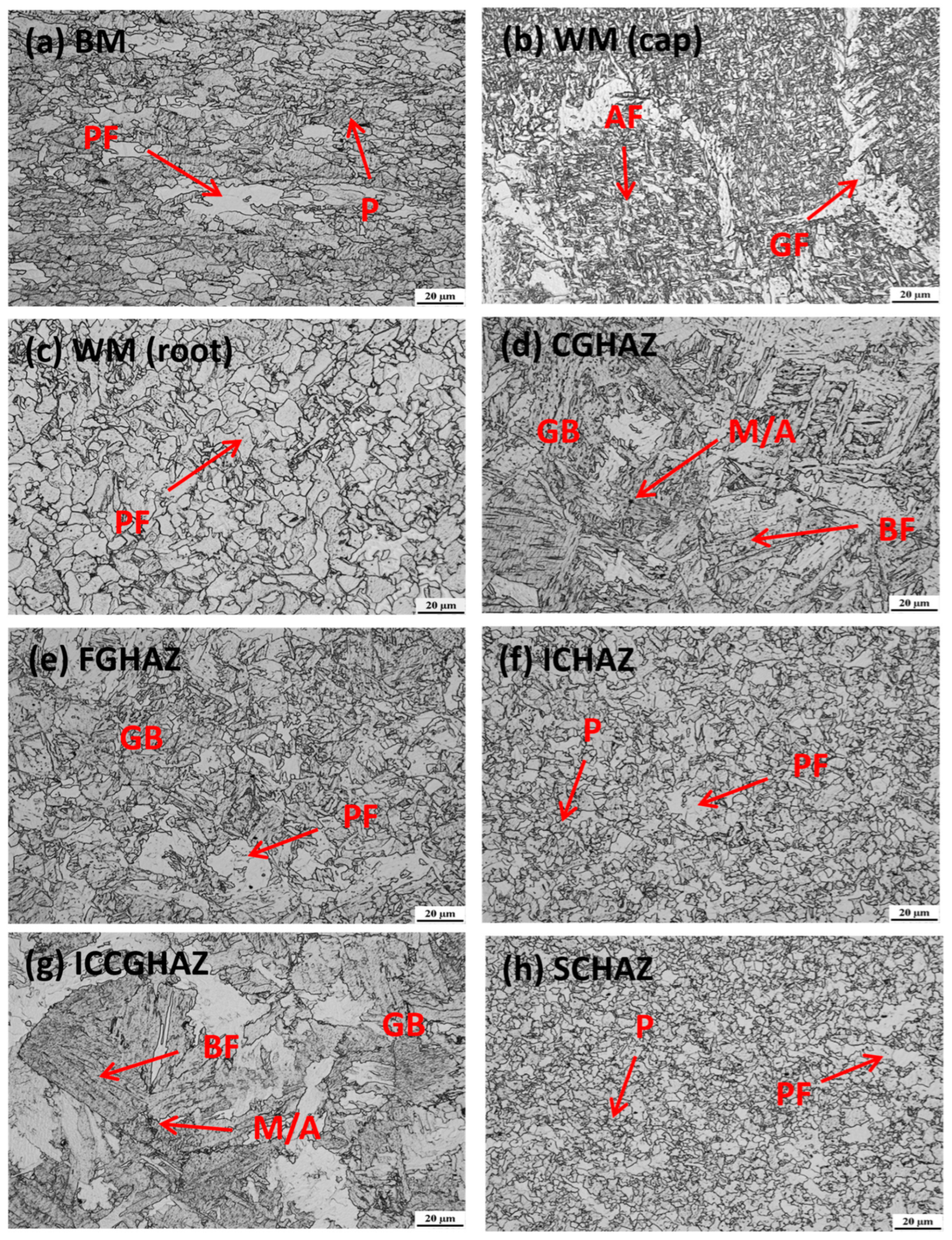

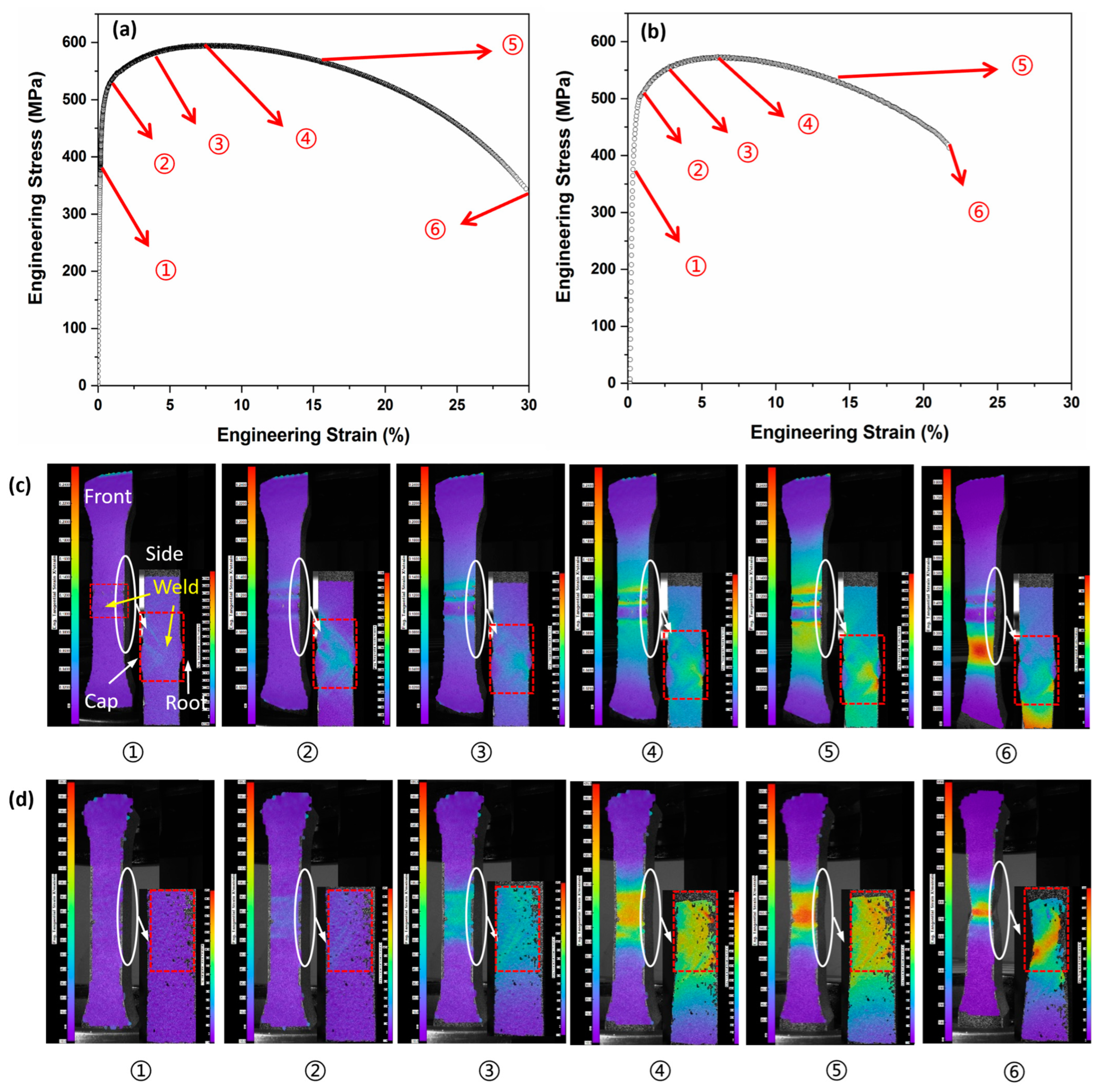

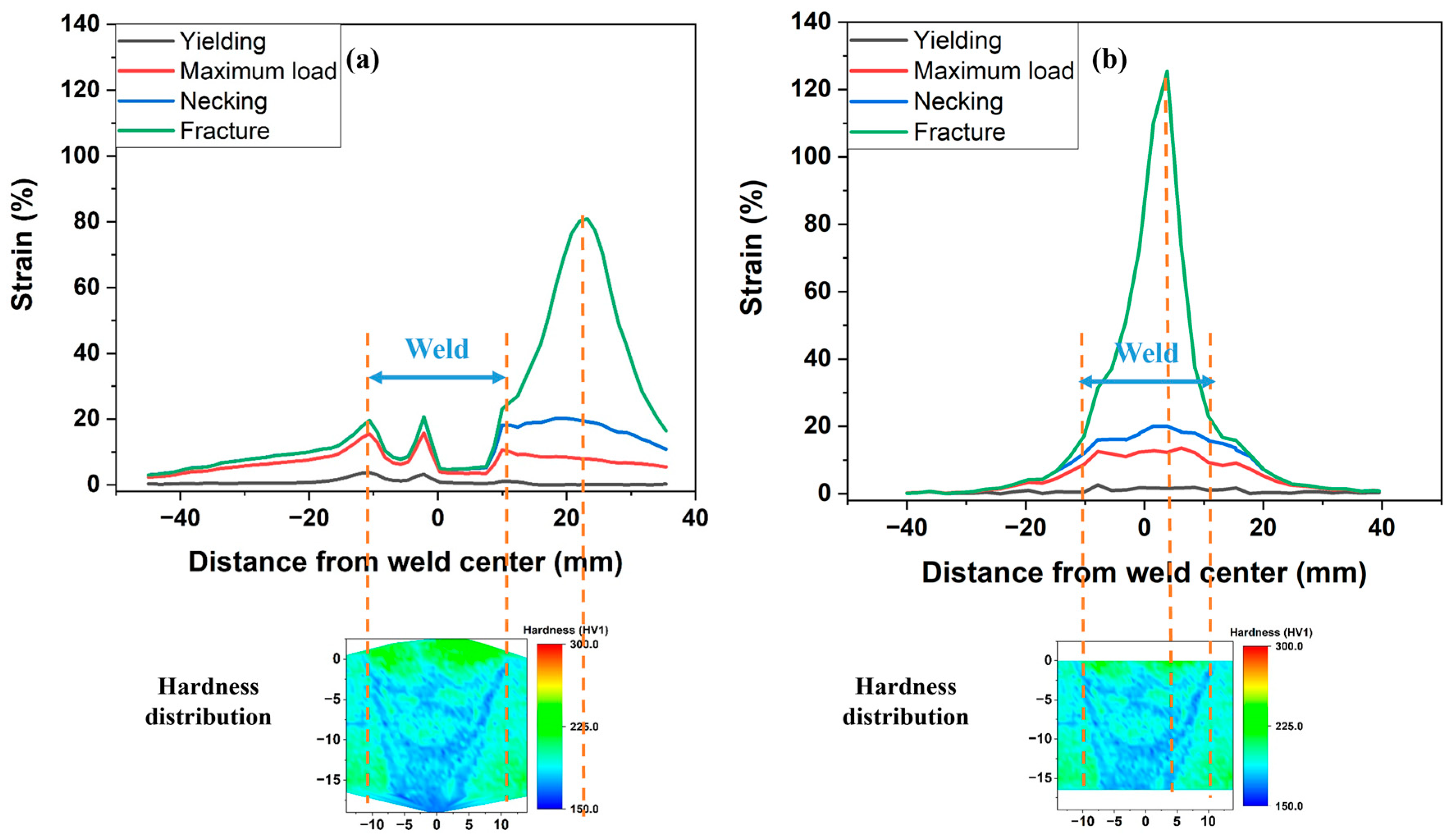
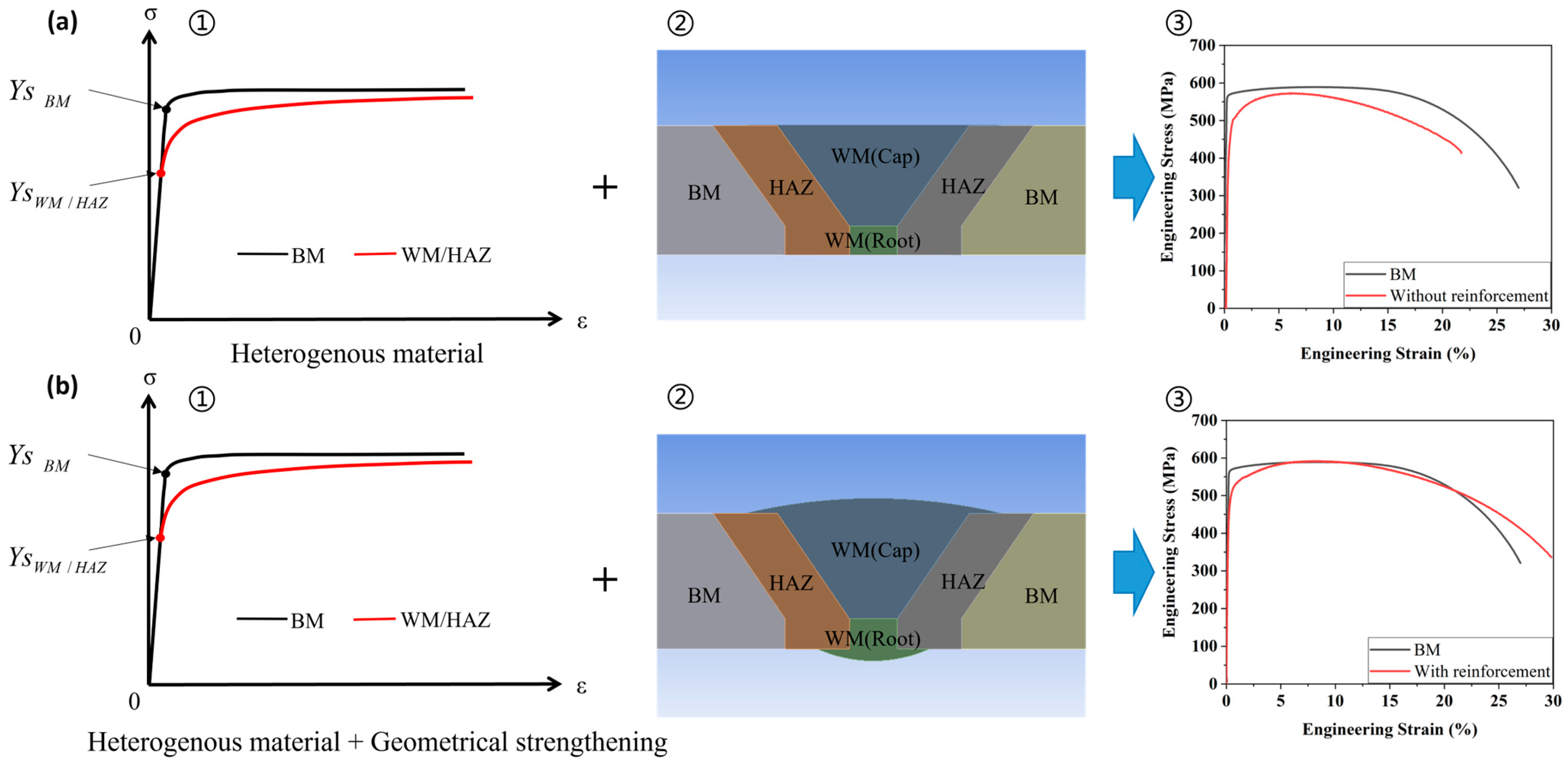
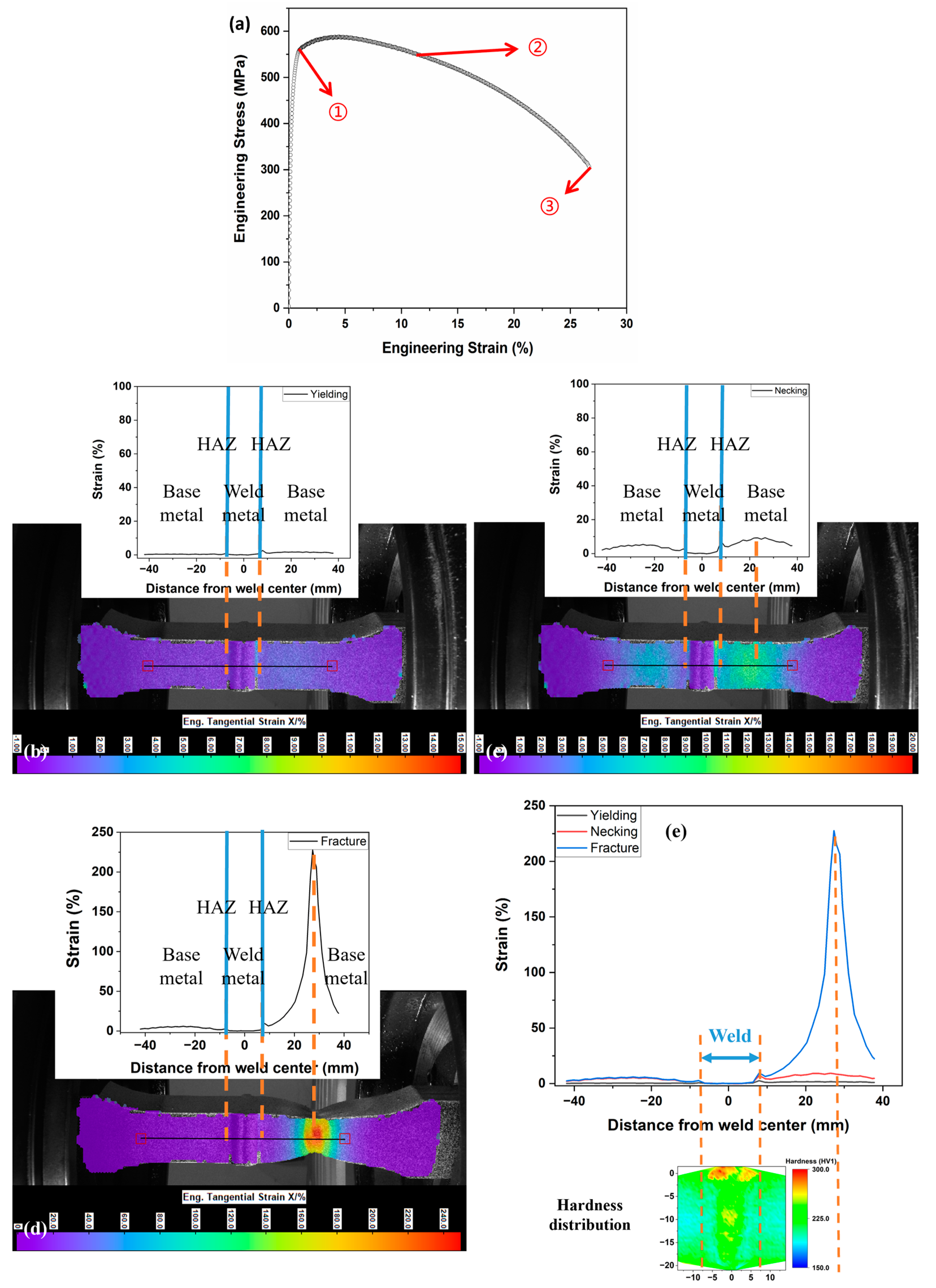
| C | Si | Mn | P | S | Cu | Ni | |
|---|---|---|---|---|---|---|---|
| P1 | 0.040 | 0.18 | 1.15 | 0.0061 | 0.0009 | 0.19 | 0.10 |
| P2 | 0.041 | 0.24 | 1.24 | 0.0061 | 0.0011 | 0.23 | 0.18 |
| Cr | Mo | V | Nb | Al | Ti | B | N |
| 0.17 | 0.059 | 0.0014 | 0.039 | 0.035 | 0.0133 | 0.0002 | 0.0034 |
| 0.16 | 0.057 | 0.0414 | 0.042 | 0.027 | 0.0061 | 0.0002 | 0.0040 |
| Base Metal | Wall Thickness | Welding Process | Welding Consumables | Heat Input Range (kJ/mm) | ||
|---|---|---|---|---|---|---|
| Root | Fill & Cap | Root | Fill & Cap | |||
| P1 | 17.5 mm | SMAW/GMAW | ER70S-G | E8018-G | 0.5~0.8 | 0.9~1.8 |
| P2 | 19.8 mm | GMAW | ER70S-G | ER70S-G | 0.4~0.6 | 0.5~1.0 |
| Yield Strength/MPa | Ultimate Tensile Strength/MPa | Elongation/% | Stain Hardening Rate | |
|---|---|---|---|---|
| With reinforcement | 525 | 590 | 30 | 0.083 |
| Without reinforcement | 502 | 571 | 21 | 0.081 |
| Base metal | 562 | 589 | 27 | 0.055 |
Disclaimer/Publisher’s Note: The statements, opinions and data contained in all publications are solely those of the individual author(s) and contributor(s) and not of MDPI and/or the editor(s). MDPI and/or the editor(s) disclaim responsibility for any injury to people or property resulting from any ideas, methods, instructions or products referred to in the content. |
© 2024 by the authors. Licensee MDPI, Basel, Switzerland. This article is an open access article distributed under the terms and conditions of the Creative Commons Attribution (CC BY) license (https://creativecommons.org/licenses/by/4.0/).
Share and Cite
Zhang, Z.; Ma, Y.; Liu, S.; Su, L.; Fletcher, L.; Li, H.; Wang, B.; Zhu, H. Inhomogeneous Strain Behaviors of the High Strength Pipeline Girth Weld under Longitudinal Loading. Materials 2024, 17, 2855. https://doi.org/10.3390/ma17122855
Zhang Z, Ma Y, Liu S, Su L, Fletcher L, Li H, Wang B, Zhu H. Inhomogeneous Strain Behaviors of the High Strength Pipeline Girth Weld under Longitudinal Loading. Materials. 2024; 17(12):2855. https://doi.org/10.3390/ma17122855
Chicago/Turabian StyleZhang, Zhihao, Yan Ma, Shuo Liu, Lihong Su, Leigh Fletcher, Huijun Li, Baosen Wang, and Hongtao Zhu. 2024. "Inhomogeneous Strain Behaviors of the High Strength Pipeline Girth Weld under Longitudinal Loading" Materials 17, no. 12: 2855. https://doi.org/10.3390/ma17122855
APA StyleZhang, Z., Ma, Y., Liu, S., Su, L., Fletcher, L., Li, H., Wang, B., & Zhu, H. (2024). Inhomogeneous Strain Behaviors of the High Strength Pipeline Girth Weld under Longitudinal Loading. Materials, 17(12), 2855. https://doi.org/10.3390/ma17122855








